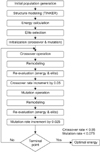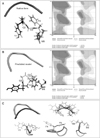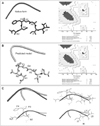1. Pedersen JT, Moult J. Genetic algorithms for protein structure prediction. Curr Opin Struct Biol. 1996; 6(2):227–231.

2. de Lima TW, Gabriel PH, Delbem AC, Faccioli RA, da Silva IN. Evolutionary algorithm to ab initio protein structure prediction with hydrophobic interactions. In : Proceedings of the IEEE Congress on Evolutionary Computation; 2007 Sep 25-28; Singapore. p. 612–619.
3. Piccolboni A, Mauri G. Application of evolutionary algorithm to protein folding prediction. In : Hao JK, Lutton E, Ronald E, Schoenauer M, Snyers D, editors. Artificial Evolution. Heidelberg, Germany: Springer;1998. p. 123–135.
4. Carnevali P, Toth G, Toubassi G, Meshkat SN. Fast protein structure prediction using monte carlo simulations with modal moves. J Am Chem Soc. 2003; 125(47):14244–14245.

5. Lee B, Kurochkina N, Kang HS. Protein folding by a biased Monte Carlo procedure in the dihedral angle space. FASEB J. 1996; 10(1):119–125.

6. Mandal S, Jana ND. Protein structure prediction using 2D HP lattice model based on integer programming approach. In : Proceedings of 2012 International Congress on Informatics, Environment, Energy and Applications; 2012 Mar 17-18; Singapore. p. 171–175.
7. Benitez CM, Lopes HS. Protein structure prediction with the 3D-HP side-chain model using a master-slave parallel genetic algorithm. J Braz Comput Soc. 2010; 16(1):69–78.

8. Cui Y, Chen RS, Wong WH. Protein folding simulation with genetic algorithm and supersecondary structure constraints. Proteins. 1998; 31(3):247–257.

9. Zhang X, Wang T, Luo H, Yang JY, Deng Y, Tang J, et al. 3D protein structure prediction with genetic tabu search algorithm. BMC Syst Biol. 2010; 4:Suppl 1. S6.

10. Hoque MT, Chetty M, Sattar A. Genetic algorithm in ab initio protein structure prediction using low resolution model: a review. In : Sidhu AS, Dillon TS, editors. Biomedical data and applications. Heidelberg, Germany: Springer;2009. p. 317–342.
11. Dandekar T, Argos P. Applying experimental data to protein fold prediction with the genetic algorithm. Protein Eng. 1997; 10(8):877–893.

12. Contreras-Moreira B, Fitzjohn PW, Offman M, Smith GR, Bates PA. Novel use of a genetic algorithm for protein structure prediction: searching template and sequence alignment space. Proteins. 2003; 53:Suppl 6. 424–429.

13. Goldberg DE. Genetic algorithms in search, optimization and machine learning. Reading (MA): Addison-Wesley Publishing Co.;1989.
14. Kaiser CE, Merkle LD, Lamont GB, Gates GH Jr, Pachter R. Case studies in protein structure prediction with real-valued genetic algorithms. In : Proceedings of the 8th SIAM Conference on Parallel Processing for Scientific Computing; 1997 Mar 14-17; Minneapolis, MN.
15. Day RO, Zydallis JB, Lamont GB, Pachter R. Solving the protein structure prediction problem through a multiobjective genetic algorithm. In : Proceeding of the International Conference on Computational Nanoscience and Nanotechnology; 2002 Apr 21-25; San Juan, Puerto Rico. p. 32–35.
16. Deerman KR, Lamont GB, Pachter R. Linkage-learning genetic algorithm application to the protein structure prediction problem. In : Proceedings of the ACM Symposium on Applied Computing; 2001 Mar 11-14; Las Vegas, NV. p. 333–339.
17. Schulze-Kremer S, Tiedemann U. Parameterizing genetic algorithms for protein folding simulation. In : Proceedings of the 27th Hawaii International Conference on System Sciences; 1994 Jan 4-7; Wailea, HI. p. 345–354.
18. Tragante-do-O V, Tinos R. A self-organizing genetic algorithm for protein structure prediction. Learn Nonlinear Model. 2010; 8(3):135–147.

19. Fogel GB, Corne DW. Evolutionary computation in bioinformatics. Boston (MA): Morgan Kaufmann Publishers;2003.
20. Klepeis JL, Pieja MJ, Floudas CA. Hybrid global optimization algorithms for protein structure prediction: alternating hybrids. Biophys J. 2003; 84(2 Pt 1):869–882.

21. Accelrys Software Inc. Discovery Studio modeling environment, release 3.1. San Diego (CA): Accelrys Software Inc.;2012.
23. Tuffery P, Etchebest C, Hazout S, Lavery R. A new approach to the rapid determination of protein side chain conformations. J Biomol Struct Dyn. 1991; 8(6):1267–1289.

24. Thierens D. Adaptive mutation rate control schemes in genetic algorithms. In : Proceedings of the 2002 Congress on Evolutionary Computation; 2002 May 12-17; Honolulu, HI. p. 980–985.
25. Bao-Juan H, Jian Z, De-Hong Y. A novel and accelerated genetic algorithm. WSEAS Trans Syst Control. 2008; 3(4):269–278.
26. Breukelaar R, Back T. Self-adaptive mutation rates in genetic algorithm for inverse design of cellular automata. In : Proceedings of the 10th Annual Conference on Generic and Evolutionary Computation; 2008 Jul 12-16; Atlanta, GA. p. 1101–1102.
27. Jay Ponder Lab. TINKER: software tools for molecular design (TINKER 3.9, June 2001) [Internet]. St. Louis (MO): Washington University;c2013. cited 2013 May 1. Available from:
http://dasher.wustl.edu/tinker/.
29. Wiltzius JJ, Sievers SA, Sawaya MR, Cascio D, Popov D, Riekel C, et al. Atomic structure of the cross-β spine of islet amyloid polypeptide (amylin). Protein Sci. 2008; 17(9):1467–1474.





 PDF
PDF ePub
ePub Citation
Citation Print
Print















 XML Download
XML Download